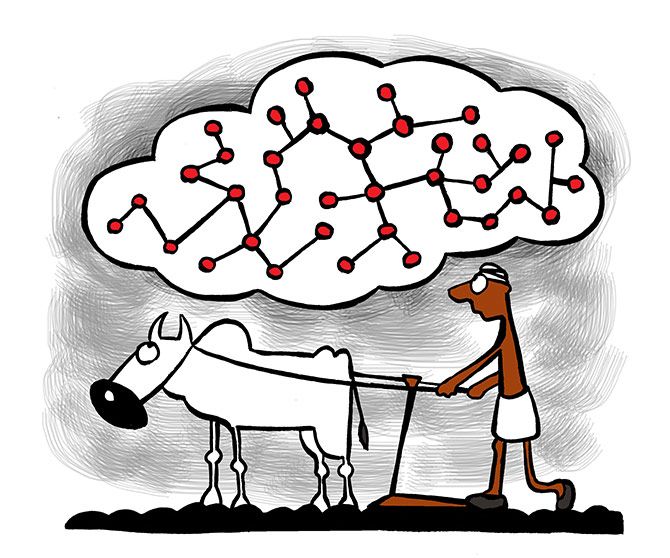'Perhaps a better question to ask would be: Is this 'Made for India'?' asks AI expert Ganesh Mani.
Illustration: Uttam Ghosh/Rediff.com

At a recent workshop I co-organised in Bangalore, with the theme of Artificial Intelligence and innovation, the discussion turned to the origin of an AI system or specifically: What is 'Made in India AI'?
Answering that question seems to be important for three reasons.
First, AI adoption is rapidly increasing.
According to technology research firm IDC, global AI spending is about $36 billion this year, up 45% from last year.
Just in the US, which pioneered some of the early AI research and applications, there are now over 2,000 AI companies and about 3,800 AI-related patent applications were filed in 2018.
DARPA, which has a multi-decade history of making investments in technology aimed at national security, has announced a $2 billion AI initiative there.
In China, there are many significant AI start-ups, including SenseTime, which touts a valuation of $7.5 billion.
Domestically, NITI Aayog has proposed a Rs 7,500 crore plan to boost AI.
Secondly, AI is not a fad; it has the potential to deliver real value, especially to people at the bottom and middle of the pyramid.
For instance, in health care, there is a great urban-rural divide both in terms of accessibility and affordability.
The Tata Memorial Hospital in Mumbai found that a significant number of new patients were travelling from states as far away as UP and Bihar to avail of treatment, often after their cancer had progressed to an advanced stage.
AI-enabled telemedicine has the potential to ameliorate this.
In general, the new AI is about augmented intelligence -- scaling expert services and also making remote delivery possible, in tandem with other technologies.
To make this a reality, India is starting to develop significant expertise in machine learning as well as language technologies.
Thirdly, increasing globalisation has spread the origins of a product and sourcing its components far and wide: An Apple iPhone is designed in the US, its parts are sourced from over a dozen countries and, until recently, was assembled primarily in China.
Contrast that with the Sony Walkman of the 1980s, which was entirely designed and produced in Japan.
The recent trade wars have made the origin of goods a focal point.
My guess is the question and ensuing discussion at the recent workshop stemmed from trepidation about the origin label being relevant to AI systems as well and, thus, with the potential to get caught up in future cross-border trade restrictions and shenanigans.
An AI system today is not general purpose enough to work facilely across multiple contexts and geographies.
It is best thought of as a triumvirate: Data, domain knowledge and techniques (or algorithms).
Faces of local people, speech reflecting the regional language; as well as dialect and scenes with every day, endemic objects are what will be readily available as inputs to a retrieval or reasoning system.
If any training is involved to teach the system, it is best to use data similar to what the system will encounter when deployed.
Likewise, domain or subject matter expertise has many rich nuances -- for example, which side of the street vehicles will be typically driven, denomination and appearance of a banknote or the uniform of a state's policeman.
Algorithms can then aid in partially or completely automating driving, paying and checking out at a retail store or in an emergency, directing people -- via their smart phones -- to a law enforcement officer for any clarifications and guidance.
While advances in search and machine learning techniques have come from many countries via global teams of researchers and are widely published, often the systems have to be re-created domestically in the country of use with local data and domain knowledge.
Such local data and domain knowledge embedding aid system performance and robustness.
Thus, 'Made in India AI' needs to be interpreted as a system trained using traffic scenes in Kanpur or a conversation in Malayalam guided by local linguistic nuances.
Given the rich diversity in languages and local customs, an AI system in many instances may have to be hyper-regionalised.
More importantly, the AI system will need to be trusted by the end-user farmer in Guwahati and its recommendations explainable in pithy Marathi by a physician in Mumbai -- over WhatsApp perhaps -- to a patient in Wardha.
In the start-up world, over the last decade or so, investors have encouraged copycat entrepreneurship: Take a successful business model that worked in the developed market(s) and execute the copy-paste routine in an emerging market.
While this has been successful in some cases, it has stifled sustainable innovation.
Copycat AI systems need to be wary of this expediency trap.
Hastily assembled AI systems built with scant attention to local data and know-how can exhibit unanticipated behaviour and have unintended consequences.
It may even end up creating a new class system.
Perhaps a better question to ask would be: Is this 'Made for India'?
We need to ensure that the system is fair, transparent and explainable to the common man in India.
Note to innovators and entrepreneurs: To guarantee an incredible India AI experience, make sure you stick with local data and expertise, even if you download the algorithms from an alien cloud!
Ganesh Mani is an AI expert, adjunct faculty member at Carnegie Mellon University, and past-President of the Pittsburgh chapter of TiE.org












 © 2025 Rediff.com -
© 2025 Rediff.com -